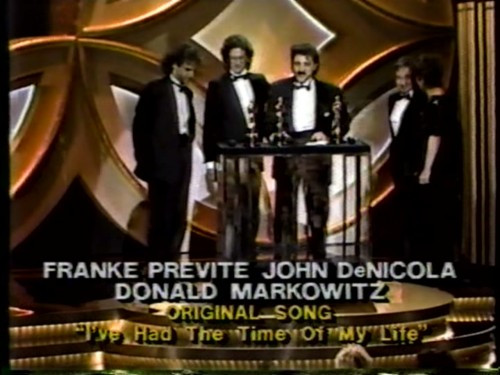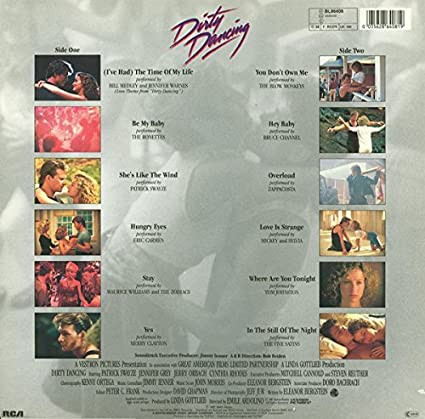The Dirty Dancing Album remains one of the most iconic and beloved soundtracks in cinematic history. More than just background music, it became a cultural phenomenon, propelling the film to even greater heights and embedding itself into the hearts of generations. But how did this magical collection of songs come to be? In this exclusive deep dive, we uncover the stories behind the hits, directly from the songwriters themselves: Franke Previte, John Denicola, and Stacy Widelitz. They reveal the serendipitous moments, creative sparks, and unexpected journeys that led to the creation of this timeless soundtrack.
From a seemingly small, independent film to a global sensation, the story of Dirty Dancing and its music is one of unexpected triumphs. Initially perceived as a low-budget project destined for a brief theatrical run before heading to video, no one could have predicted the cultural impact it would have. Even the songwriters themselves were initially unaware of the magnitude of what they were creating.
 Dirty Dancing soundtrack
Dirty Dancing soundtrack
The iconic cover of the Dirty Dancing album, a symbol of 80s music and cinematic romance.
The Genesis of “She’s Like the Wind”
Stacy Widelitz recounts the origin of “She’s Like the Wind,” a song inextricably linked with Patrick Swayze, both as a performer and co-writer. Interestingly, the song wasn’t originally conceived for Dirty Dancing at all.
“We actually wrote it when he was working on a different film called Grandview USA,” Widelitz explains. Swayze, whom Widelitz affectionately called “Buddy,” reached out to him seeking help with a song idea for the movie. “He called me up and said, ‘They’re looking for songs for Grandview. I’ve had this idea for a song for a couple of years and I can’t get anywhere with it. You want to work on it with me and submit it for Grandview?'”
The collaboration sparked quickly. Swayze visited Widelitz, guitar in hand, and shared his initial chords and lyrical ideas. Widelitz, at the piano, helped refine the melody and lyrics, recognizing the power of the opening line. “I think the turning point was when we realized that ‘She’s Like the Wind,’ rather than just being the opening line of the song, was also the hook and title.”
Despite Widelitz’s growing involvement in Dirty Dancing through Swayze’s connections, initial industry buzz was far from positive. “The word on the street was that it was a bad movie,” Widelitz remembers. Even his agent tempered expectations, suggesting it would be a minor credit on his resume at best. This low expectation persisted even during the recording process. “So ultimately, even when we were recording the final version of it, at Michael Lloyd’s studio, I was really not that excited.”
However, the cast and crew screening offered a different perspective. Widelitz and his girlfriend at the time were pleasantly surprised. “We walked out of it saying, ‘You know, that wasn’t nearly as bad as everybody said. It was actually kind of warm hearted and good, a little cheesy in parts.'” This initial positive reaction was a hint of the sleeper hit Dirty Dancing was about to become, fueled in no small part by its memorable soundtrack, featuring “She’s Like the Wind”.
“Hungry Eyes”: From Franke and The Knockouts to the Big Screen
Franke Previte shares the story of “Hungry Eyes,” a song that had a previous life before becoming synonymous with Dirty Dancing. It originated during his time with Franke and The Knockouts, a band that enjoyed significant success in the early 80s.
“Yes, through Jimmy Ienner again,” Previte confirms, referencing the music executive who played a pivotal role in his career and the trajectory of “Hungry Eyes”. After Franke and The Knockouts’ initial success, label changes and creative differences led to a period of uncertainty. However, Previte continued writing, collaborating with David Prater and John Denicola. It was through this collaboration that “Hungry Eyes” emerged.
“David played me a track that I got an instant vibe for,” Previte recalls about Denicola’s music. “So, I asked David, ‘Can I talk to John and maybe see if it’s ok if I try and put a melody and lyric to it.’ John was all in. Yeah, that very first attempt bore fruit. A song called ‘Hungry Eyes’ which was written for the fourth Franke and the Knockouts 4th album was created.”
Years later, Jimmy Ienner re-entered Previte’s life, this time with the Dirty Dancing project. Initially hesitant due to time constraints, Previte was persuaded by Ienner’s strong intuition about the film. “He said ‘Make time. This is going to change your life.’ and I’m like, ‘Yeah, right. You’re going to change my life?’ so he goes, ‘No, no, I got a good feeling about this movie.'”
The film’s title, Dirty Dancing, initially raised eyebrows for Previte, who humorously admits, “that’s when my hand went to my forehead and i thought OMG ‘Jimmy’s doing porn. He’s doing a porn flick.'” Despite the initial misjudgment, Previte recognized the opportunity and immediately contacted John Denicola. Their existing songwriting partnership proved crucial in delivering another iconic track for the Dirty Dancing album: the repurposed “Hungry Eyes,” perfectly capturing the film’s passionate atmosphere.
The Accidental Magic of “(I’ve Had) The Time of My Life”
The story of “(I’ve Had) The Time of My Life,” the Dirty Dancing album‘s Oscar-winning centerpiece, is filled with delightful serendipity and near misses. Franke Previte and John Denicola detail the song’s journey from a vague movie scene description to a global anthem.
Previte recounts the initial, somewhat cryptic, direction from Jimmy Ienner: “Jimmy had given Franke sort of direction about what he had with a closing scene. We didn’t see any footage or anything, but he told Franke that there was a dance instructor and the girl, his wallet has been stolen and he’s in trouble.” Tasked with creating a seven-minute song for this final scene, Previte enlisted John Denicola and Donny Markowitz.
Denicola describes their collaborative process: “From the description that Franke got from Jimmy, we kind of pounded out something that started slowly with some strings and then picked up to a tempo that they could dance to.” They drew inspiration from The Blues Brothers and Irene Cara’s “What a Feeling,” aiming for a dynamic piece that could underscore the film’s emotional climax.
Previte vividly recalls the moment the lyrics and melody for “(I’ve Had) The Time of My Life” came to him. “On my way back to that studio up in Montclair on the Garden State Parkway, exit 140, I stuck the cassette in my dashboard back in 1986. And I start jamming and that’s how I write a song as I jam to the track. So this track that John and Donny sent me kind of inspired me to jam the lyrics while driving and the first words, I had ‘The time of my life’, spit out of my mouth and the song was born.”
This spontaneous burst of creativity, born from the music and the open road, resulted in the title and the core idea of the song. Previte humbly attributes the rest to divine inspiration: “to tell you the truth, the man upstairs wrote the rest of the song because I didn’t know what the movie was about. John didn’t really know what the movie was about. And I wouldn’t have written that song in a million years because it was out of the realm of who I was as an artist.”
The demo, featuring Previte’s tenor vocals, became the version used for filming, influencing the choreography and the film’s emotional tone. The search for vocalists to perform the final version was extensive, considering iconic names like Donna Summer and Diana Ross. Ultimately, the pairing of Bill Medley and Jennifer Warnes proved to be perfect.
Previte explains the casting choice’s brilliance: “What a perfect match because Jennifer Warnes was with Joe Cocker for ‘Up Where We Belong’, an Academy Award winning song. And Bill had always wanted to sing with her.” Medley, initially hesitant, eventually agreed, and his baritone voice, an octave lower than Previte’s demo, brought a soulful gravitas to the song. “So then all of a sudden Bill sings ‘Time of my Life’ in a lower range which worked out perfectly, now he could do his Bill Medley thing, which when you look back at the movie and you think of a contemporary movie that was trying to depict 1964. That’s when Bill Medley and the Righteous Brothers were really popular. And so he was the thread that connected this commercially pop contemporary song to the past.”
This confluence of factors – the song itself, the perfect vocal pairing, and its resonance with the film’s themes – cemented “(I’ve Had) The Time of My Life” as a timeless classic and a cornerstone of the Dirty Dancing album‘s enduring appeal.
 time-of-my-life-oscar
time-of-my-life-oscar
Franke Previte and John Denicola accepting the Oscar for Best Original Song for “(I’ve Had) The Time of My Life,” a pinnacle moment for the Dirty Dancing album.
Demo-itis and the Magic of the Original Sound
Both Stacy Widelitz and Franke Previte touch upon the phenomenon of “demo-itis,” where the raw, initial demo recordings held a certain magic that proved difficult to replicate perfectly in the final versions. Patrick Swayze himself expressed a preference for the demo of “She’s Like the Wind.”
Widelitz recounts, “Knowing Patrick/Buddy, very well, he said to me at one point, he said, ‘You should have heard the original demo. It was so much better than that final version.’ He loved the demo.”
Similarly, Eleanor Bergstein, the writer of Dirty Dancing, favored Franke Previte’s demo vocals for “(I’ve Had) The Time of My Life.” Previte explains the demo’s impact: “Even Eleanor Bergstein, the writer of the movie, will say to you, ‘I love what Bill and Jennifer did, but my favorite is when Franke sang it.’ It was the first time they heard it. They had to listen to 149 songs to that point and ‘Time of my Life’ was the 150th song.”
This “demo-itis” highlights the often-unquantifiable spark of creativity captured in initial recordings, a testament to the raw energy and emotion that fueled the Dirty Dancing album.
From Sleeper Hit to Cultural Phenomenon
The initial lukewarm industry reception to Dirty Dancing stands in stark contrast to its eventual blockbuster success. Stacy Widelitz recalls the low expectations surrounding the film’s release, while John Denicola describes witnessing the audience’s reaction firsthand.
Denicola shares a pivotal moment of realization: “I remember one of the first weekends it was in the theaters. I was living on Eighty Third Street at that moment. And I went to the theater and it was pretty crowded. But the whole movie was over. People looked excited. But I saw the people directly in front of me sitting and waiting and waiting for the titles to go down. And then they went and as soon as the ‘Time of my Life’ came out, they went, ‘Oh, that’s the song that’s the time in my life.’ That’s when I knew, you know, maybe we have something here.”
This audience connection, particularly with the music, fueled the film’s rise from a “sleeper hit” to a cultural phenomenon. The Dirty Dancing album became an essential part of this success, with the songs and the movie propelling each other to greater heights. “first, the movie kind of pushed the song. And then the song got momentum and it kind of pushed the movie, so it was a kind of a once in a lifetime experience, really,” Denicola reflects.
The unexpected demand for the soundtrack was staggering. Franke Previte recounts the rapid shift from low expectations to overwhelming popularity: “within that two week period, there were, I think, 300,000 records backordered and RCA was like, ‘Oh, shit. You know, let’s get some records pressed here’. And by the time that they could press records and get them out to their distributors, I think there were a million records back ordered.”
Stacy Widelitz vividly remembers the surreal experience of receiving a platinum record award, far exceeding the initial gold record he was anticipating. “Last Sunday it sold 280,000 and and that’s when he said to me, ‘We’re riding the wave of something and none of us have any idea where it’s taking us.’ And that was interesting because that was also dead on.”
The Dirty Dancing album ultimately achieved 11-times platinum status in the US, a testament to its enduring popularity and cultural impact.
 dirty dancing soundtrack
dirty dancing soundtrack
The back cover of the Dirty Dancing album, showcasing the tracklist that became the soundtrack of a generation.
The Alignment of Stars: A Lasting Legacy
The songwriters consistently emphasize the extraordinary confluence of factors that contributed to the phenomenal success of Dirty Dancing and its soundtrack. Franke Previte summarizes it perfectly: “The stars aligned, it was the right time for Patrick and Jennifer and the song and the movie and Bill and Jennifer again. And like I said, take one of those elements out, take the song out, take Patrick out, one of those elements and you don’t have the phenomenon.”
John Denicola adds the crucial contribution of director Emile Ardolino, highlighting his unique vision and ability to bring Eleanor Bergstein’s script to life. Stacy Widelitz points to Ardolino’s background in dance documentaries as a key reason for his hiring and his sensitivity to the film’s core themes.
The Dirty Dancing album is more than just a collection of songs; it’s a cultural artifact representing a specific moment in time, a coming-of-age story interwoven with unforgettable music. The songwriters’ insights reveal the human element behind this phenomenon – the chance encounters, creative collaborations, and sheer luck that coalesced to create a soundtrack that continues to resonate with audiences worldwide. The legacy of the Dirty Dancing album endures, not just as a testament to great songwriting, but as a reminder of the magic that happens when all the elements align perfectly.

